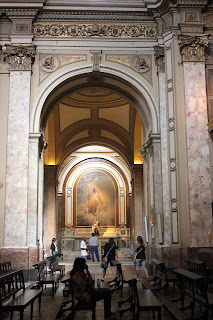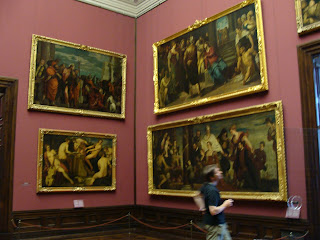Tuesday 27 November 2012
Sunday 25 November 2012
Tuesday 13 November 2012
Sunday 11 November 2012
Tuesday 6 November 2012
Galata Museo del Mare
The Galata, with 10,000 square metres of exhibition spaces, is the largest maritime museum in the Mediterranean.
17 large halls, reconstructions of port and shipyard environments, multimedia and interactive stations on the first and second floors, spectacular audio and visual effects, integrate with the rich exhibition of nautical instruments, atlases, nautical charts, arms and antique paintings.
An educational and at the same time enthralling visit. And ever changing.
In the ambits of the ancient Arsenal of the Republic of Genoa you can relive the history of navigation from the oar to the sail and from steamships to luxurious cruise ships.
A voyage in time to discover the relationship of man with the sea.
17 large halls, reconstructions of port and shipyard environments, multimedia and interactive stations on the first and second floors, spectacular audio and visual effects, integrate with the rich exhibition of nautical instruments, atlases, nautical charts, arms and antique paintings.
An educational and at the same time enthralling visit. And ever changing.
In the ambits of the ancient Arsenal of the Republic of Genoa you can relive the history of navigation from the oar to the sail and from steamships to luxurious cruise ships.
A voyage in time to discover the relationship of man with the sea.
Useful info
Galata Museo del Mare
Calata De Mari - Darsena
Tel. +39 010 2345655
www.galatamuseodelmare.it
accoglienza@galatamuseodelmare.it
Calata De Mari - Darsena
Tel. +39 010 2345655
www.galatamuseodelmare.it
accoglienza@galatamuseodelmare.it
Font:
www.portoantico.it/index.aspx?codpage=galatamuseo&lang=eng
Sunday 4 November 2012
Zwinger - Gemäldegalerie Alte Meister
Can there be anyone who is not familiar with the two cheeky little cherubs who perch so cutely at the feet of the “Sistine Madonna”? They have been enchanting visitors to the Gemäldegalerie Alte Meister for more than 250 years now. By purchasing the “Sistine Madonna”, August III, Elector of Saxony and King of Poland, fulfilled his long-held desire to become the owner of an original work by Raphael.
Most of the major works to be admired in the Gemäldegalerie Alte Meister today were assembled within a period of little more than half a century. Although it is true that numerous paintings were already held in the Kunstkammer of the Electors of Saxony, which was founded in 1560, the systematic collecting of paintings did not begin until the reigns of August the Strong (1670 – 1733) and, in particular, his son August III (1696 – 1763). His agents purchased 16th, 17th and 18th-century masterpieces all over Europe. In 1746 they succeeded in making a particularly spectacular purchase: 100 masterpieces were bought from the collection of the Duke of Modena, all of them works by top-ranking artists and thus of inestimable value. The following year, the Gemäl¬degalerie was moved to the converted Electoral Stable Building on the Jüdenhof. In 1855 the gallery building designed by Gottfried Semper and constructed next to the Zwinger was opened. This was one of the most important museum projects of the 19th century in Germany, and it is here that the collection is still housed today. During the Second World War, most of the paintings were evacuated for safe-keeping and were not damaged. After the end of the war, the paintings – like the holdings of many other museums – were taken by the Red Army to Moscow and Kiev. Following the return of the art treasures in 1955/56, reconstruction work began on the gallery building, which had been severely damaged in the war, and shortly afterwards it was reopened. The two cherubs are still idly lolling at the bottom of the picture, apparently oblivious to their countless admirers.
Subscribe to:
Posts (Atom)








































